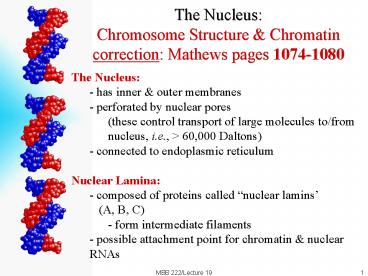The Nucleus: Chromosome Structure - PowerPoint PPT Presentation
1 / 13
Title:
The Nucleus: Chromosome Structure
Description:
dsDNA wraps around the nucleosome two times. February 18, 2000. MBB 222/Lecture 19 ... assembly of histones with DNA requires, a molecular chaperone, nucleoplasmin ... – PowerPoint PPT presentation
Number of Views:79
Avg rating:3.0/5.0
Title: The Nucleus: Chromosome Structure
1
The Nucleus Chromosome Structure
Chromatincorrection Mathews pages 1074-1080
- The Nucleus
- - has inner outer membranes
- - perforated by nuclear pores
- (these control transport of large molecules
to/from nucleus, i.e., gt 60,000 Daltons) - - connected to endoplasmic reticulum
- Nuclear Lamina
- - composed of proteins called nuclear lamins
- (A, B, C)
- - form intermediate filaments
- - possible attachment point for chromatin
nuclear RNAs
2
Nucleus the components
- nucleolus a ribosome-producing
sub-compartment of the nucleus - nucleoplasm
chromatin/ chromosome-containing region -
endoplasmic reticulum (ER) shares nuclear
membrane (perinuclear space) site where
ribosomes inject newly-made proteins that are
destined to be incorporated into membranes
(e.g., cell surface) or be secreted - nuclear
pore complex (NPC) highly complex proteinaceous
pore that regulates the entry/exit of proteins,
and exit of mRNA - nuclear lamina provides
structural rigidity to nucleus and possible sites
of attachment for chromosomes, etc.
3
- Chromatin
- - chromatin is the protein DNA complex in which
chromosomes exist in the nucleus - (i.e., the physical state of chromosomes during
interphase) - - during metaphase, chromatin (which is a
relatively loose spread-out structure)
condenses into the familiar metaphase
chromosomes - The Nucleolus
- - specialized region of the nucleus with densely
stained chromatin in electron micrographs - - site of rRNA genes of ribosome assembly
- - rRNA transcripts
- about 80 proteins (from the cytoplasm)
- many RNAs
- - small and large ribosome subunits (40S, 60S)
are exported to the cytoplasm separately
assembled processed
4
Chromatin
Chromatin is composed of one long, continuous DNA
chain, or chromosome (up to 10cm long for human
chromosomes 3.5 x 108 bp) - DNA is organized
in very elaborate ways to condense it to a
manageable size
5
Levels of Chromatin Organization
nucleosome (10 nm Fiber)
30 nm fiber physiologically important structure
DNA
Loops
compacted metaphase chromosome
Loops
?
These are only models at this stage
The loops of 30 nm fibers contain 20,000
100,000 bp (i.e., about the sizes of genes)
6
- Topoisomerase II is associated with loops (30nm)
suggests individual loops may be autonomously
supercoiled - Allows for independent regulation of
supercoiling chromatin structure for specific
regions - Even higher-order organization is required than
the higher-order loops for metaphase condensation - Protein scaffolds appear to be involved
- Regulated (?) by Histone H1 phosphorylation
- - 5 serine residues phosphorylated during
condensation
7
2 nm DNA double helix
10 nm Nucleosome (10 nm fiber)
30 nm 30 nm Fiber
300 nm Loops I
700 nm Loops II
1400 nm chromosome
Figure 8.30 Alberts, Mol. Biol. Cell.
8
Nucleosome
- in the presence of Histone H1, 175-200 bp DNA
is wrapped around the nucleosome If H1 is
removed, 146 bp Histone H1 - helps clamp the
DNA onto the nucleosome - participates in
higher-order chromatin folding
9
Compaction of DNA
Each nucleosome serves to compact DNA Compaction
ratio 680 Å / 100 Å 7 (DNA 200 bp /
nucleosome size) 10 Å 1 nm However, total
condensation of metaphase chromosomes 1 m ? 100
?m (104 packing ratio) - therefore mucleosomes
only play a small part
10
Histones
dsDNA wraps around the nucleosome two times.
dsDNA
11
Schematic of formation of 30nm chromatin fiber
DNA
Histones
12
Histones (Components of the nucleosome)
The major protein component of chromatin. -
small, very basic (lys, arg) proteins (to
neutralize the highly charged DNA) - assembly of
histones with DNA requires, a molecular
chaperone, nucleoplasmin Five Types of
Histones H1 Clamp for DNA wrapped around
nucleosome H2A H2B H3 H4 H4 Is very highly
conserved between species (98 identical between
cows and peas) 1 change in 600 million
years H3 Is also very conserved (97 identical)
Found in 2 copies of each in the nucleosome The
DNA is then wrapped around the protein core made
of these proteins -- together they form an octamer
Core Histones
13
Histone modifications
- Histones are also found to be modified in order
to regulate - chromosome Structure Compaction
- gene Activity
- The types of modifications are
- Phosphorylation of serines (as previously
mentioned) - Acetylation of Lys

